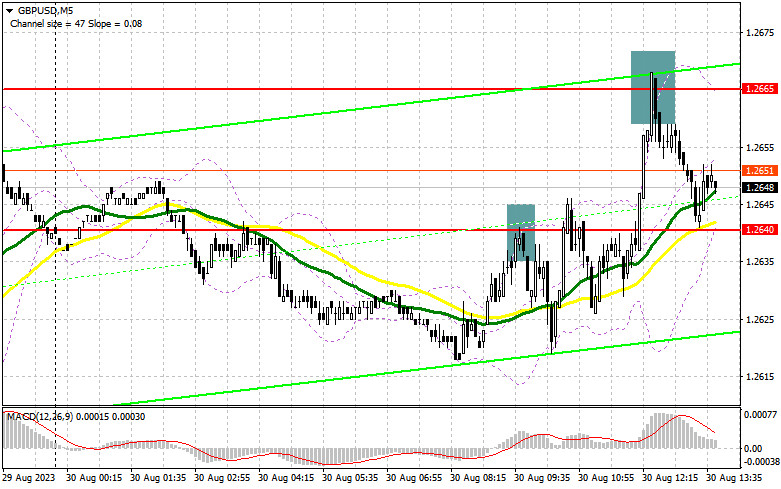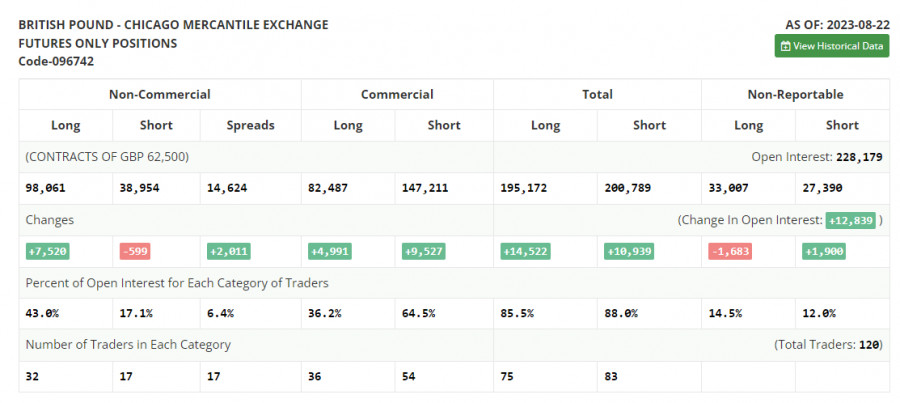
In my morning forecast, I highlighted the 1.2640 level and recommended using it as a decision point for market entry. Examining the 5-minute chart, we can see what transpired. The growth and formation of a false breakout at this level provided an excellent selling entry point, resulting in a drop of 20 points. After breaching 1.2640, the focus shifted to defending 1.2665. Another selling signal provided an additional entry point, leading to a further fall in GBP/USD by 25 points. The technical picture was revisited for the second half of the day.

To open long positions on GBP/USD:
The pound is being bought at every decline, so the latter half of the day may also be under buyers' control. Weak ADP employment change figures for August are anticipated. If the data disappoints even more, as was the case with yesterday's consumer confidence, we can expect the bullish scenario for GBP/USD to continue. The numbers on the change in the volume of pending home sales and the US trade balance in goods will also be significant.
If the US labor market surprises again with strong figures, I will act only after a decline and the formation of a false breakout at 1.2621 – a new support level established in the first half of the day. This will signal to buy the pound, aiming for a recovery of around 1.2665. Breaking and testing this range from above will provide an additional buy signal, strengthening the pound and paving the way to resistance at 1.2695. If we go above this range, we can expect a surge to 1.2725, where I will be taking profits. If GBP/USD falls and buyers are absent at 1.2621, which is also likely, the pair's pressure will intensify, leading to another sell-off around the support of 1.2586. Purchases there will only be on a false breakout. Opening long positions on GBP/USD immediately on a rebound can be done from 1.2563, aiming for a correction of 30-35 points within the day.
To open short positions on GBP/USD:
Bears have tried to assert themselves several times, but the market is still under buyers' control. The optimal scenario for opening short positions will be a failed consolidation above 1.2665 during the US labor market data release. This will provide an excellent entry point for a decline to the new support at 1.2621, where the moving averages, which favor the bulls, are located. A breach and a reverse test of this range from below will allow for sales targeting 1.2586, representing a significant GBP/USD correction. The further target will be around 1.2563, where I will be taking profits. Bulls will continue to control the market if GBP/USD rises and bears are absent at 1.2665 in the latter half of the day. In such a case, only a false breakout around the next resistance at 1.2695 will provide a short entry point. If there's no activity, I recommend selling GBP/USD from 1.2725, aiming for a 30-35 point intra-day rebound.


Indicator signals:
Moving Averages:
Trading is conducted above the 30 and 50-day moving averages, indicating the development of a bullish scenario.
Note: The author considers the period and prices of the moving averages on the H1 hourly chart and differs from the general definition of classical daily moving averages on the D1 daily chart.
Bollinger Bands:
In case of a decline, the lower boundary of the indicator, around 1.2620 will act as support.
Indicator Descriptions:
Moving average (determines the current trend by smoothing out volatility and noise). Period: 50. Marked in yellow on the chart.Moving average (determines the current trend by smoothing out volatility and noise). Period: 30. Marked in green on the chart.MACD Indicator (Moving Average Convergence/Divergence). Fast EMA: Period 12. Slow EMA: Period 26. SMA: Period 9.Bollinger Bands. Period: 20.Non-commercial traders are speculators, such as individual traders, hedge funds, and large institutions that use the futures market for speculative purposes and meet certain requirements.Non-commercial long positions represent the total open long positions of non-commercial traders.Non-commercial short positions represent the total open short positions of non-commercial traders.The total non-commercial net position is the difference between non-commercial traders' short and long positions.